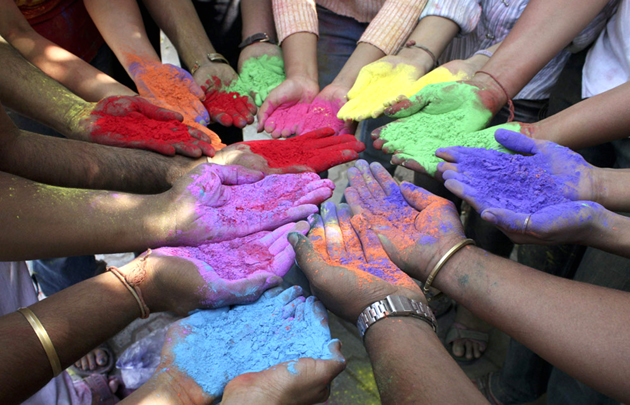O P Sharma
One of India’s unique festivals is colourful Holi which is celebrated with enthusiasm and gaiety on the full moon day in the month of Phalgun ( March) this year.
The people of Jammu and Kashmir too observe week-long holi culminating on March 27, which is a public holiday for playing with colours and festivity. Being the end of cold winter and heralding of Spring season, it is time for rejoicing and merry-making during the Holi.
The people of Jammu and Kashmir are very fond of fairs, festivals and social gatherings and eagerly await for this festival of colours and joy also known as Spring Festival. Nature too, it seems rejoices at the arrival of Holi and wears its best cover of green fields, multi-coloured flowers bloom and expectation of good harvest rise high up.
The rulers have been taking part in holi festival by exchanging sprinkling colour water with the ruled. In the past, a procession was taken through the main bazars of Jammu in which scented colour water was sprayed on the spectators. In democratic set up some of the top politicians and the public together celebrate this joyous festival of colours and fun.
Holi may be celebrated with various names and people of different States following different traditions but this unique occasion has special spirit and style which reflect the underling unity of the country. Even across the globe, it is celebrated with solemnity.
During the Holi the entire country wears a festive look. Market places get abuzz with activity with huge quantity of various hues of gulal and colours. Pichkaris in innovative and modern designs too hit the shops every year to lure the customers who sprinkle colours on their friends, relatives and others. It is noteworthy that friends and foes mingle together during this occasion. Choice dishes and sweets are prepared and served to the friends and relatives.
Root in Legend
Holi festival has few mythological legends associated with it. One is that a demon king Hiranyakashyap who demanded everybody in his kingdom to worship him instead of the Almighty but his pious son, Prahlad, a devotee of Lord Vishnu was conspired to be killed. According to the story, the king asked his sister Holika (with a boon of immunity from burning ) to enter a blazing fire with Prahlad. But as the fate would have it, amazingly, Holika vanished but Prahlad survived the fire. Since that time, people light a bonfire, on the occasion of Holi festival and celebrate the victory of good over evil and also the triumph of devotion to god. Children take special delight in the tradition.
Some also celebrate the death of evil-minded Pootana who had tried in vain to kill infant Lord Krishna by feeding poisonous milk under an evil plan of Kansa, Krishna’s devil uncle. However, Krishna sucked her blood and brought her end. Another instance of victory of good over the evil. Lord Krishna played Holi with Radha and other Gopis and the tradition is followed ever since.
The spirit of Holi encourages the feeling of brotherhood in society and even the enemies turn friend on this day. People of all communities and even religions participate in this joyous and colouful festival and strengthen the secular fabric of the nation.
It is so much fun to watch the otherwise sober people making a clown of themselves in full public display. Caution should be taken to avoid intoxicants of any sort and colour should be sprinkled not to damage eyes or any other body part. After a fun filled and exciting day, the evenings are spent in sobriety when people meet friends and relatives and exchange sweets and festive greetings.
Great excitement can be seen among the people for the play of colours. Shops and offices remain closed for the day and people get all the time to get crazy and make fun whacky. Bright colours of gulal and scented water are poured on each other. Children take special delight in spraying colours on one another with their pichkaris and throwing water balloons. Groups called tolis move in different areas – applying colours and exchanging greetings. Songs and dance are the other highlights of the day.
Lovers too long to apply colours on their loved ones. This has a popular legend behind it. It is said that the naughty Lord Krishna started the trend of playing colours on Radha. The trend soon gained popularity amongst the masses.
No wonder, there is no match to the Holi of Mathura, Vrindavan and Barsana – the places associated with the birth and childhood of Radha and Krishna. Holi is a clean but colourful festival and must be celebrated with due solemnity and purity of spirit to make life itself colourful with sense of high moral values.
(Starline Syndicate Service)
Trending Now
E-Paper


